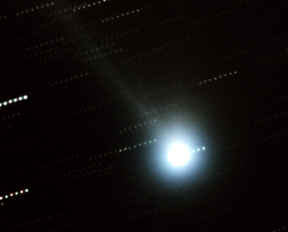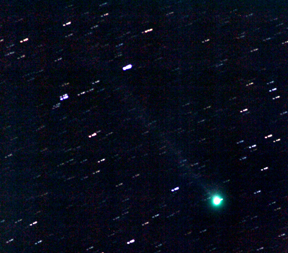There are probably billions of comets in our Solar System, and relatively few of these actually pass close enough to the Sun to develop a coma and tail. The most famous in recent memory was comet Hale-Bopp back in 1997, but I was not photographing at that time (and was in Middle School).
Comets are incredibly difficult to photograph for two main reasons. First, the coma - or head - is very bright, but the tail (or tails) are very faint. Second, when comets are bright, they are close to the Sun, and this means that they move very quickly. Over the course of just a few minutes, they will visibly move relative to the background of stars, and so only short exposures can be taken unless you have a very special tracking system (which I don't have at the moment ... anyone want to donate $1.5k?).
The best one of 2006 was way too close to the Sun in the Northern Hemisphere to photograph, but folks in the Southern Hemisphere got some amazing photos. The second-best was Comet SWAN, which is shown below.
Comet 2006/M4 SWAN


Click Any Image for a Larger Version
Better known as Comet SWAN, this comet was visible in the Fall and early Winter of 2006. It was just barely visible to the naked eye (magnitude +6) until late October when it suddenly flared to magnitude +4.5, or about 5x brighter.
I am showing two views of images I took. The top one was taken with the CCD camera at SBO on CU Boulder's campus but it only shows a very narrow view (the coma and a bit of the tail). The comet's tail was several degrees long (about 10x the size of the full moon), so I also photographed it with a normal (narrow-angle) camera lens. The actual CCD image shows much fainter stars because it is of scientific quality, whereas my camera is just consumer-level.
The stars in the image are dotted lines. This is because multiple exposures were combined, and as I stated above, the comet moved relative to the background of stars, so the images had to be shifted in order to align the comet in each one.
| Object | Comet 2006/M4 |
| Common Name | Comet SWAN |
| Date, Time, & Moon | October 28, 2006; No Moon |
| Location | SBO Telescope at CU Boulder |
| Optics | 8" (20.3 cm) Cassegrain; 80" (200 cm) focal length; f/10 300 mm zoom lens; f/5.6 |
| Camera | ST-2000 Canon Digital Rebel 350D XT |
| Exposure Details | 8 stacked 4-minute images (32 minutes total) 12 stacked 1-minute images (12 minutes total); ISO 100 |
| Optical Correction | Dark- and Flatframe-Correction |
| Camera Position | Prime Focus Normal camera operation. |
| Guiding | Passive Clock Drive |
| Processing Details | CCDOps - Standard arithmetic reduction. PhotoShop CS - Colorized, adjusted levels, curves, and color. PhotoShop CS - Averaging and Levels/Curves adjustment. |
| Image Size | Approx. 32.7 by 24.5 arcmin. Approx. 6° by 6°. |
| Magnitude Depth | Coma magnitude was around +4.5 - +5.0 at time of observation. |
| Notes | This was the first comet I ever imaged, and it obviously shows 'cause it doesn't look too great. I'm still quite happy in the sense that I think it's cool that I could actually image a comet. |